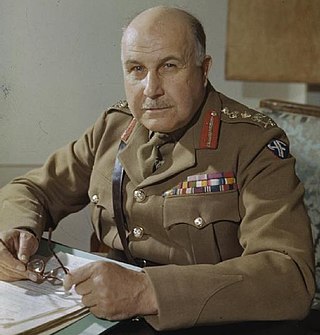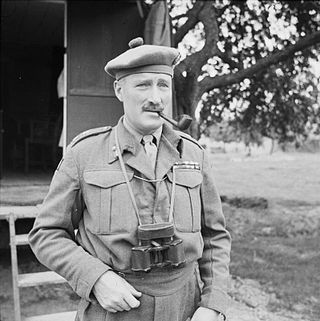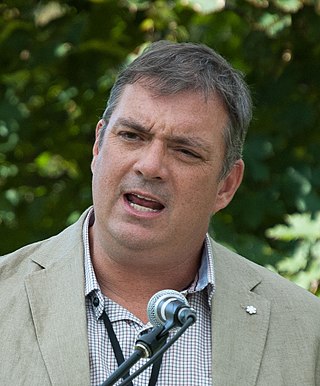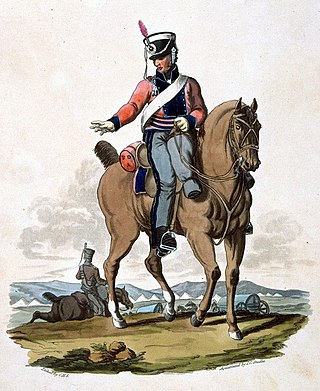Related Research Articles

Field Marshal Sir Claude John Eyre Auchinleck,, , was a British Indian Army commander who saw active service during the world wars. A career soldier who spent much of his military career in India, he rose to become commander-in-chief of the Indian Army by early 1941 during the Second World War. In July 1941 he was appointed commander-in-chief of the Middle East Theatre, but after initial successes, the war in North Africa turned against the British-led forces under his command, and he was relieved of the post in August 1942 during the North African campaign.

Field Marshal Henry Maitland Wilson, 1st Baron Wilson,, also known as Jumbo Wilson, was a senior British Army officer of the 20th century. He saw active service in the Second Boer War and then during the First World War on the Somme and at Passchendaele. During the Second World War he served as General Officer Commanding-in-Chief (GOC-in-C) British Troops in Egypt, in which role he launched Operation Compass, attacking Italian forces with considerable success, in December 1940. He went on to be Military Governor of Cyrenaica in February 1941, commanding a Commonwealth expeditionary force to Greece in April 1941 and General Officer Commanding (GOC) British Forces in Palestine and Trans-Jordan in May 1941.

Field Marshal Archibald Percival Wavell, 1st Earl Wavell, was a senior officer of the British Army. He served in the Second Boer War, the Bazar Valley Campaign and the First World War, during which he was wounded in the Second Battle of Ypres. In the Second World War, he served initially as Commander-in-Chief Middle East, in which role he led British forces to victory over the Italian Army in Eritrea-Abyssinia, western Egypt and eastern Libya during Operation Compass in December 1940, only to be defeated by Erwin Rommel's Panzer Army Africa in the Western Desert in April 1941. He served as Commander-in-Chief, India, from July 1941 until June 1943 and then served as Viceroy of India until his retirement in February 1947.

The Coldstream Guards is the oldest continuously serving regular regiment in the British Army. As part of the Household Division, one of its principal roles is the protection of the monarchy; due to this, it often participates in state ceremonial occasions. The Regiment has consistently provided formations on deployments around the world and has fought in the majority of the major conflicts in which the British Army has been engaged.

Brigadier Eric Edward "Chink" Dorman-Smith, who later changed his name to Eric Edward Dorman O'Gowan, was an Irish officer whose career in the British Army began in the First World War and closed at the end of the Second World War. In the 1950s, Dorman-Smith became an officer in the Irish Republican Army (IRA).

The Royal Military College (RMC), founded in 1801 and established in 1802 at Great Marlow and High Wycombe in Buckinghamshire, England, but moved in October 1812 to Sandhurst, Berkshire, was a British Army military academy for training infantry and cavalry officers of the British and Indian Armies.
To be mentioned in dispatches describes a member of the armed forces whose name appears in an official report written by a superior officer and sent to the high command, in which their gallant or meritorious action in the face of the enemy is described.

Sir Hew Francis Anthony Strachan, is a British military historian, well known for his leadership in scholarly studies of the British Army and the history of the First World War. He is currently professor of international relations at the University of St Andrews. Before that Strachan was the Chichele Professor of the History of War at All Souls College, Oxford.

Middle East Command, later Middle East Land Forces, was a British Army Command established prior to the Second World War in Egypt. Its primary role was to command British land forces and co-ordinate with the relevant naval and air commands to defend British interests in the Middle East and eastern Mediterranean region.

General Sir Neil Methuen Ritchie, was a British Army officer who saw service during both the world wars. He is most notable during the Second World War for commanding the British Eighth Army in the North African campaign from November 1941 until being dismissed in June 1942. Despite this, his career did not end. Ritchie later commanded XII Corps throughout the campaign in Northwest Europe, from June 1944 until Victory in Europe Day in May 1945.

The Cardwell Reforms were a series of reforms of the British Army undertaken by Secretary of State for War Edward Cardwell between 1868 and 1874 with the support of Liberal prime minister William Ewart Gladstone. Gladstone paid little attention to military affairs but he was keen on efficiency. In 1870, he pushed through Parliament major changes in Army organisation. The German Empire's stunning triumph over the Second French Empire in the Franco-Prussian War proved that the Prussian system of professional soldiers with up-to-date weapons was far superior to the traditional system of gentlemen-soldiers that Britain used.

The 5th Dragoon Guards was a British army cavalry regiment, officially formed in January 1686 as Shrewsbury's Regiment of Horse. Following a number of name changes, it became the 5th Regiment of Dragoon Guards in 1804.
General Sir Alfred Reade Godwin-Austen, was a British Army officer who served during the First and the Second World Wars.

13th Corps was a corps-sized formation of the British Army that fought on the Western Front during the First World War and was reformed for service during the Second World War, serving in the Mediterranean and Middle East throughout its service.

General Sir John Francis Martin Whiteley, was a senior British Army officer who became Deputy Chief of the Imperial General Staff (DCIGS). A career soldier, Whiteley was commissioned into the Royal Engineers from the Royal Military Academy, Woolwich in 1915 during the First World War. During the war he served in Salonika and the Middle East.

Tim Cook is a Canadian military historian and author. Cook is an historian at the Canadian War Museum and the author of thirteen books about the military history of Canada. Having written extensively about World War I, Cook's focus shifted to Canada's involvement in World War II with the 2014 publication of the first volume in a two-volume series chronicling Canada's role in that war. He is a two-time recipient of the C.P. Stacey Prize, a two-time recipient of the J.W. Dafoe Book Prize, and a three-time winner of the Ottawa Book Prize. He was elected to the Royal Society of Canada in 2019. He is a member of the Order of Canada.
Peter Caddick-Adams TD, VR, FRHistS, FRGS is a British academic historian, author and broadcaster who is specialized in military history. He is known for books on 20th-century warfare, television work, and battlefield tours.

The Cavalry Staff Corps was a unit formed during the Napoleonic Wars to keep discipline in the British Army. Consisting of four troops of cavalry, the corps was first raised in 1813 during the Peninsular War to deal with an excess of criminality and desertion in the Duke of Wellington's armies. It was disbanded after that campaign ended in 1814 but was reformed in 1815 during the Hundred Days campaign. The corps also served in the subsequent occupation of France. The unit was Britain's first standing military police force. A successor unit was raised for service in the Crimean War of 1853–1856 and a permanent military police was established in 1877.
The Army Records Society is a text publication society for the history of the British Army. The society was established in 1984 and is a registered charity. To date the society has issued 41 volumes of material.
Christopher Thomas Atkinson was the preeminent tutor for British military history at the University of Oxford in the first half of the twentieth century.
References
- Society for Army Historical Research
- The society entry at the Register of Charities, including some of the recent annual reports.